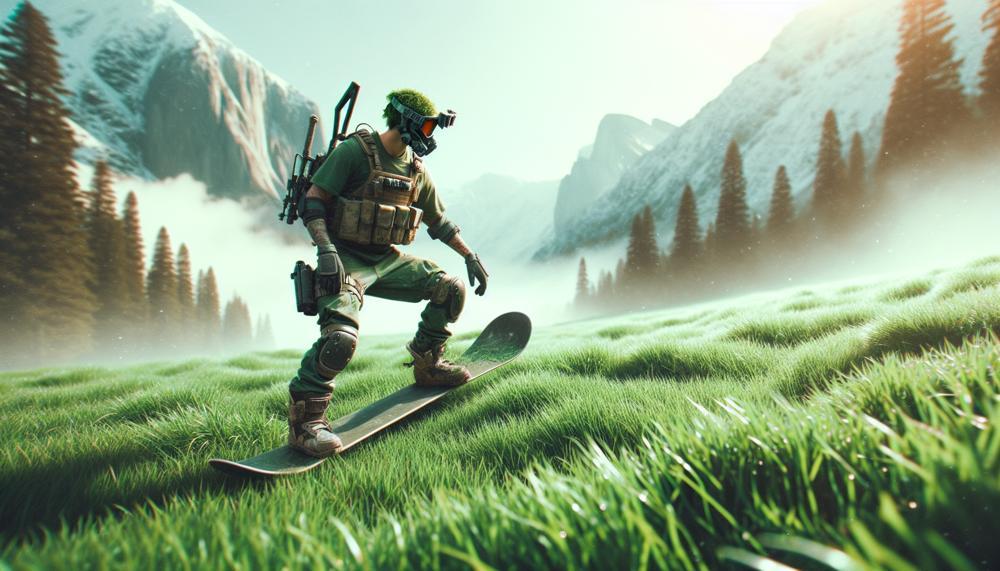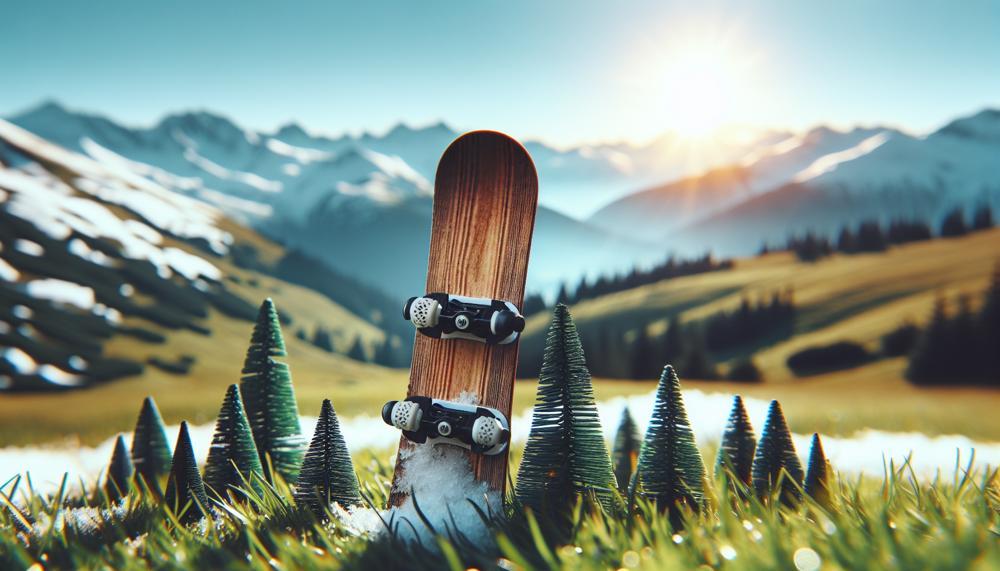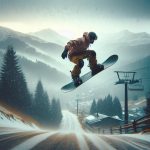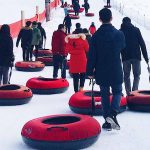As you glide down the lush, green slope, the crisp air nips at your cheeks. The sun is shining, the birds are chirping, and you’re shredding on a snowboard…on grass? Yes, you read that right – we’re talking about the latest trend in extreme sports – grass snowboarding.
But before you dismiss it as just another backyard sledding experience, hear us out. Grass snowboarding is not your average activity. It’s a thrilling and challenging sport that combines the rush of snowboarding with the beauty of nature. And with its growing popularity among adventure seekers, it’s time to take a closer look at this unique way to ride.
In this blog post, we’ll dive into the world of grass snowboarding and explore everything from its origins to its benefits.
So, can you snowboard on grass?
Yes, you can snowboard on grass. Some say it’s fun to do at the end of the season when trails are narrow and grass starts to appear. You can turn on grass, but not as well as on snow.
Here are some things you can do on grass with a snowboard:
- Press jumps: 90° and 180° jumps are similar to what you would do on snow.
- Surf and snowboard down grass hills: You can use water and soap to make the grass slippery.
- Practice flat ground spins and jumps: However, some say that grass will just get your board all green.
So, buckle up and get ready for an exhilarating ride through the world of grass snowboarding.
Grass and Snow as Frenemies
Contents
When it comes to the exhilarating sport of snowboarding, grass and snow share a complex relationship. While snow is an essential element for this adrenaline-fueled activity, grass is not a suitable surface for it.
However, thanks to advancements in technology, there are now artificial surfaces specifically designed for snowboarding on grass.
These surfaces replicate the slippery feel of snow, providing a controlled ride for snowboarders.
| Interaction | Description |
| Positive | The artificial surfaces designed for snowboarding on grass offer a controlled ride that closely resembles that on snow. |
| Negative | Unfortunately, grass does not offer the same slick and smooth surface as snow, which can affect the optimal performance of snowboarders. Additionally, it can also cause damage to their equipment. |
| Neutral | While snow and grass may not have a direct interaction, they serve different purposes in the world of snowboarding. |
On the other hand, grass also plays a crucial role in the lesser-known sport of grassboarding. It serves as the surface for this unique and challenging activity that combines elements of mountainboarding and sandboarding.
However, despite its similarities to other board sports, grassboarding has faced criticism due to its potential environmental impact and has yet to gain widespread popularity like its snow-based counterpart.
Grass Skiing Reimagined
Grass skiing has been transformed into a new and exciting experience with the recent development of artificial surfaces that simulate the texture and sensation of snow, allowing for grass snowboarding. These cutting-edge surfaces, such as Snowflex and Neveplast, consist of synthetic plastic bristles that are watered down to create a slick and snow-like surface. This groundbreaking technology has revolutionized grass skiing and snowboarding, providing year-round opportunities for riding and training.
Not only do these artificial surfaces offer a similar experience to natural snow, but they also have the added advantage of being environmentally friendly. Unlike traditional ski resorts that rely on energy-intensive snowmaking, these synthetic grass surfaces require significantly less energy and water for maintenance. This makes them a sustainable choice for both recreational and professional snowboarders.
One of the pioneers in this field is Dr. Daniel Scott, a professor of geography and environmental management, who has been studying the impact of climate change on the ski industry. He believes that grass skiing and snowboarding can play a crucial role in ensuring the future of the sport in a warmer climate.
In addition to addressing climate change challenges, grass skiing has also opened up new possibilities for the sport by expanding its reach to new locations. With these artificial surfaces, it is now possible to set up snowboarding courses in areas without natural snowfall, making the sport more accessible to people worldwide.
Dry Slopes More Common Around World
The increasing trend of dry slopes can be attributed to their accessibility, controlled environment for learning, year-round availability, cost-effectiveness, and sustainability. These factors make dry slopes a desirable choice for snowboarding enthusiasts looking to hone their skills in a convenient and budget-friendly manner.
Dry slopes are becoming more common around the world due to their various advantages over traditional snow-covered slopes. These artificial ski and snowboarding surfaces are designed to mimic the feel of real snow, providing a similar experience to that of traditional slopes. However, they offer additional benefits such as being open year-round, regardless of weather conditions.
The controlled environment of dry slopes also makes them an ideal place for beginners to learn and practice. Unlike natural slopes, which can have unpredictable terrain and weather, dry slopes offer a consistent and safe space for learning. This allows beginners to progress at their own pace without worrying about unexpected challenges.
Moreover, dry slopes are more cost-effective than traditional snow-covered slopes. The maintenance costs of dry slopes are significantly lower, making them a more affordable option for individuals or families looking to enjoy winter sports. Additionally, since they do not rely on natural snowfall, they are not subjected to seasonal price increases like traditional ski resorts.
Dry slopes are sustainable and eco-friendly. With climate change threatening the future of winter sports, these artificial surfaces provide a solution by reducing the reliance on natural snow. They also eliminate the need for expensive and energy-consuming snowmaking machines.
Grass Slope Disadvantages
| Elevated possibility of harm | Snowboarding on grass can present a higher likelihood of injury compared to snowboarding on a snow-covered slope. This is due to the rough and unforgiving nature of grass, where falls can result in scrapes, bruises, and even broken bones. |
| Limited control and maneuverability | Grass does not provide the same level of glide and traction as snow, making it more challenging to execute certain moves or tricks. Jumps and spins may not have the same height or rotation due to the lack of traction on grass. |
| Shorter window for snowboarding | Unlike snow, which can last for months in certain regions, grass slopes are only suitable for snowboarding during specific times of the year. This limitation can be frustrating for passionate snowboarders who want to practice year-round. |
| Potential damage to equipment | Snowboarding on grass can cause harm to equipment such as boards and bindings. The rough surface of grass can scrape and wear down the base of the board, affecting its performance on snow. |
| Limited variety of terrain | Grass slopes usually do not offer the same diverse range of terrain features as a snow-covered slope. This can restrict snowboarders’ development and progression in different aspects of the sport. |
| Adverse impact on the environment | Snowboarding on grass can have a negative impact on the environment. The constant friction of snowboards on grass can damage natural vegetation and soil, leading to erosion and loss of habitat for wildlife. |
The Green, Green Slopes of Home
Snowboarding on grass has become increasingly popular as a summertime alternative to traditional snowboarding. Although it may seem like an exciting and unconventional experience, there are both advantages and disadvantages to consider.
Benefits:
- Year-round activity: Grass skiing enables athletes to continue their training and improve their skills throughout the year, even during the off-season when there is no snow.
- Smooth transition: By preventing the need for constant reseeding and maintenance, grass skiing allows for a smoother transition from winter to spring for lawns.<
- Unique experience: Snowboarding on grass offers a distinct experience compared to traditional snowboarding, with its own set of challenges and techniques.
Drawbacks:
- Higher risk of injury: Without the cushioning of snow, falling on grass while snowboarding can result in more serious injuries.
- Limited control and terrain options: Grass skiing does not provide the same level of control and diverse terrain options as traditional snowboarding.
- Potential damage to equipment: The heat generated by the plastic surface used in grass skiing may potentially damage snowboarding equipment.
- Negative impact on the environment: Grass skiing requires the use of an artificial surface, which could have adverse effects on the environment.
When to Call a LawnStarter Pro

Caring for your lawn can be an overwhelming task, but it’s crucial for keeping your yard looking beautiful and vibrant. If you’re unsure about when to call a LawnStarter Pro for your lawn care needs, here are some signs to keep an eye out for:
- Poor lawn condition: If your lawn is appearing overgrown, dry, or patchy, it may be time to seek professional assistance. A LawnStarter Pro can offer expert care and help restore your lawn’s health and lush appearance.
- Limited time and effort: Lawn care requires a significant amount of time and effort, especially if you have a large yard. If you find yourself struggling to keep up with mowing, edging, and other lawn care tasks, it’s time to call in the professionals. They can take the weight off your shoulders and allow you to focus on other important tasks.
- Lack of knowledge or skills: Lawn care can be complex, and not everyone has the expertise to properly care for their lawn. If you’re unsure about the best methods for fertilization, weed control, or dealing with pests, it’s best to leave it to the experts. A LawnStarter Pro has the necessary knowledge and skills to handle all aspects of lawn care effectively.
- Need for specialized equipment: Maintaining a well-manicured lawn requires specialized equipment that can be costly to purchase and maintain. A LawnStarter Pro has all the necessary tools and equipment to provide top-notch lawn care services. By hiring them, you can save money on purchasing expensive equipment and ensure that your lawn receives the proper care it deserves.
- Busy schedule: In today’s fast-paced world, many individuals have hectic schedules that leave little time for lawn maintenance. If this sounds like you, it’s time to call a LawnStarter Pro. They can work around your schedule and handle all your lawn care needs while you focus on your other responsibilities.
- Property value: Your lawn is often the first thing people see when they visit your home. A well-maintained lawn can greatly contribute to your property’s curb appeal and overall value. Calling a LawnStarter Pro can help you maintain a beautiful lawn and enhance the aesthetic of your home.
- Cost-effective: While some may believe that hiring a professional lawn care service is expensive, it can actually save you money in the long run. A LawnStarter Pro can provide efficient and effective lawn care, preventing costly issues such as pest infestations or over-fertilization. Their services are also customizable, so you only pay for what you need.
Also Read: Are Snowboard Bindings Universal?
Conclusion
In conclusion, while it may seem unconventional and even impossible at first, grass snowboarding offers a unique and exhilarating experience for adventure seekers. Its growing popularity is a testament to its appeal and the potential it holds for the future of snow sports.
Throughout this blog post, we have explored all aspects of this exciting new sport – from its origins to its benefits. We have also delved into the complex relationship between grass and snow in the world of snowboarding, as well as how innovative technology has transformed grass skiing into a sustainable and inclusive activity.
Additionally, we have highlighted the advantages of using dry slopes for smoother rides and improved safety. And with dry slopes becoming more common around the world, they offer a convenient and cost-effective alternative for learning and training.






